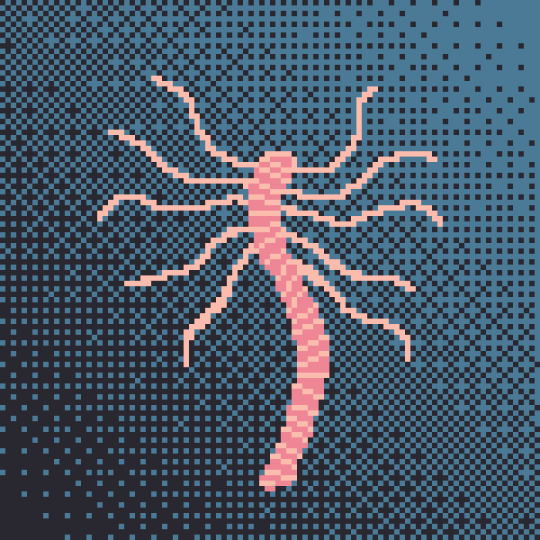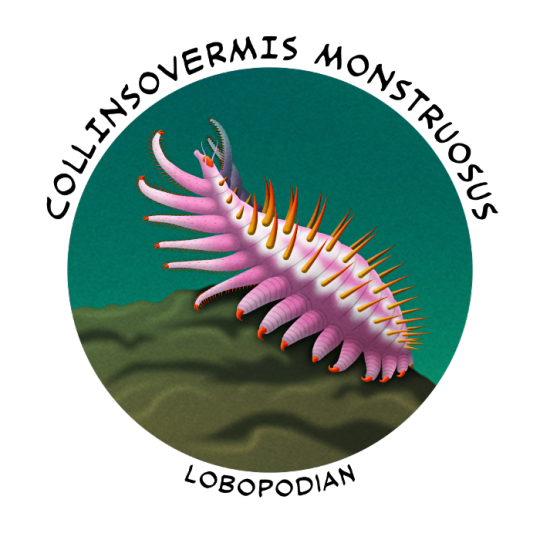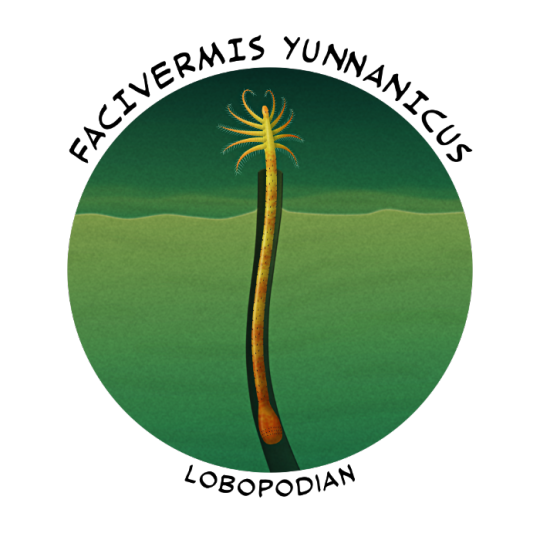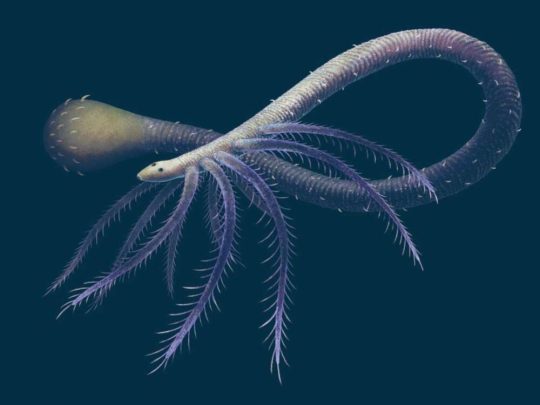#facivermis
Explore tagged Tumblr posts
Text

Dinovember day 5, Facivermis! I'm tired so I don't have facts, but it's a funky worm, enjoy it -w-
#art#digital art#sombertide art#paleoart#paleontology#natural history#paleo#cambrian#dinovember#facivermis#worm#palaeoblr#palaeontology#palaeoart
105 notes
·
View notes
Text

every day i am in awe that facivermis is a real creature that existed. it looks like a fucking spongebob character. truly one of the best autism creatures of its time. one of the first animals to ever de-evolve in order to live in a tube and look stupid as fuck. i love you facivermis
31 notes
·
View notes
Text

Another extinct pixel critter, the lobopod facivermis. Wiggly!
[ID: A pixel art depiction of the extinct lobopod facivermis, rendered in two different shades of pink with the background in a gradient from light teal to dark teal. /ID]
17 notes
·
View notes
Text
Me, posting art on this account? *coughs* anyway, I have a few original settings swirling around in my head. One of them involves shapeshifting dragons/weredragons, with designs based on sea creatures and medieval bestiaries. Tiamat exists in the setting, depicted closer to her roots as a primordial sea goddess and the creator of said dragons, as well as a bunch of other things. It’s a little half-baked rn but I came up with a great design idea for her that I wanted to share… namely, to base her off of Paleozoic sea life!

This is what I’m thinking will be her preferred form. Primary insps include anomalocaris (armor and “wings”), dunkleosteus (placoderm “teeth”) trilobite (horns), some jawless fish whose name escapes me atm (tail), crinoid (“hair”), lamprey and tully monster (gills), and coelecanth (pectoral fins). Currently the one thing I’m undecided on is to keep it to just two eyes, or to give her five like an opabinia.
She is a shapeshifter, so she can change this up and frequently does! - In combat, she loses the “hair” and instead grows Wiwaxia-like spines. - When she needs to grab or handle something in a nonviolent context, she grows tendrils like that of a Facivermis - When she needs to grab or handle something in a violent context, she’ll go for anomalocaris grabby-things, or pincers and legs like a horseshoe crab or eurypterid - When she needs to go on land for whatever reason, she opts for horseshoe crab or eurypterid legs as well, I did a very, very rough sketch of this:

the scuttlerrrrrrr
#art#my art#my worldbuilding#sketch#digital art#human artist#tiamat#sea#paleozoic#anomalocaris#dunkleosteus#trilobite#lamprey#crinoid#wiwaxia#coelacanth#dragon#dragon design#fish dragon#sea dragon#sea goddess
63 notes
·
View notes
Text
wwm reboot, p1: cambrian explosion
similar to the original this would follow a day (or days, considering its a full episode) in the life of anomalocaris. in many ways i think it should follow a similar structure to the first episode if wwd, as an homage, though with a few changes. we'll get there after the roster list.
there are 5 animals i want to include here, though not all of them are known from the same or even nearby formations:
anomalocaris, aegirocassis, omnidens, as well as the obligatory trilobite and finally: a vetulicolian
though 4 of these lived at a similar time, two of the three named genus's are almost certainly going to be dropped unless we specifically cater to them.
thankfully, the Maotianshan Shale provides:
Anomalocaris canadensis, the protagonist
Omnidens amplus, a MUCH larger competitor and potential predator to anomalocaris, though easily avoided
Hallucigenia, Facivermis, and a few similar lobopods will showcase the evolutionary responses to both major carnivores.
Priapulid worms will mostly be fodder, but still showcase some defensive behaviors, and will allow for the discussion of worm world and the wormpocalypse, detailed by Eons yt
Synophalos, Tuzoia, and will have similar functions to the lobopods, but in open water. they will also showcase the strangeness of the era.
either Fuxianhuia or Chengjiangocaris will showcase that even during this period animals have already evolved complex brains, likely through parental care.
several megacheirans will be included, such as Haikoucaris and Leanchoilia, mostly to showcase the smaller nectic carnivores, but Parapeytoia will lead to a small rant on the difficulty of fossil cladistics, and whether anomalocaris could walk. (it couldn't)
Artiopods, especially trilobites (Yunnanocephalus, in particular) will be featured, mostly showcasing the power of an exoskeleton, but also the diversity of artiopods beyond trilobites, and a likely ancestor to the next episodes main threat.
Inquicus and Cricocosmia would be showcased only for the parasitic relationship the two have, which shows complexity.
Wiwaxia p and Orthrozanclus will also showcase armor and its benefits, though perhaps not against all hunters.
one could include Yunnanozoon. for shits and giggles. it and Haikouichthys would act as ideal prey for the protagonist.
Vetulicola will once again showcase the benefits of armor, even among stem chordates. also coca.
the Maotianoascus and other "comb jellies" will be in a similar boat to Haikouichthys.
sponges like Choia may show off peculiarities, but Hazelia will just be easier to include, due to its normality.
finally, other radiodonts Lyrarapex and Amplectobelua will be included, with the former acting as prey (alongside a few more) and the latter being another predator ending the episode.
well. that was a lot. lets write about it! we'll begin with a very similar sequence to the actual WWM, with a male anomalocaris bullying some trilobites and other scavengers, but instead of eating them he snatches a carcass they've gathered around. we then meet our actual protagonist, a female of this species, who he attempts to woo, but is fought by an older male who gets an early shot. the fight ends with the wounded, younger male leaving due to an injured fin which reduces his flexibility and agility.
we follow the female anomalocaris for the rest of the episode, as she encounters several armored lobopods and attempts to catch a wirm, before coming across a smell in the water, indicating a large carcass. there are no benthic scavengers in the area, but when she gets close we meet one of the few things that can threaten and even eat her: an Omnidens. we linger with the giant for some time, encountering some strange animals which have adapted to such carnivores in a peculiar way: symbiosis.
we return to our girl attempting catch some haikouichthys in a series of rocks. in frustration she grabs a trilobite, trying to break it open. she discards it, upset, swimming on.
now we meet a more familiar animal, other radiodonts, hunting the young of a very defensive mother. quickly our anomalocaris strikes, snatching her smaller cousins, she finally gets a meal, and continues off to lay/birth.
before she gets there, she encounters get another radiodont: amplectobelua.
i personally feel like the end of that encounter should be her death and failure to reproduce, showing the extinction of these animals, but im never gonna make this shit. i think p2 should be its own post so. its gonna be its own post.
#suryp writes?#suryp... speaks???#walking with monsters#walking with dinosaurs#cambrian#paleoblr#paleozoic era#paleontology#paleomedia
2 notes
·
View notes
Text
cambrian days of the week
MAROCELLA monday
TULLY MONSTER tuesday
WIWAXIA wednesday
TRILOBITE thursday
FACIVERMIS friday
HALLUCINGENIA saturday
ANOMALOCARIS sunday
15 notes
·
View notes
Photo


Cambrian Explosion #40: Phylum(?) Lobopodia – Then Somehow They Got Weirder
Most lobopodians looked fairly similar to each other, many resembling armored velvet worms, but some of these early panarthropods evolved much more diverse body plans and ecologies during the mid-Cambrian.
And compared to most of its slender relatives, Collinsovermis monstruosus was built like a tank. An absolute unit.
Originally discovered in 1983 in the Canadian Burgess Shale deposits (~508 million years ago), for several decades this species was known only by the nickname of "Collins' monster", after paleontologist Desmond Collins who published a single image of the fossil in 1986. It was finally formally described and named in 2020, and while our current understanding of lobopodians makes it seem a bit less bizarre than it did in the 80s, it's still one of the most unique-looking members of the group.
It was part of a lineage of lobopodians known as luolishaniids, which specialized several pairs of their front limbs into feathery appendages used for filter-feeding.
About 3.5cm long (1.5"), its large chunky body had 6 pairs of long spiny feeding appendages and 8 pairs of stout legs, each ending in a single massive hooked claw. Up to three long sharp spines adorned each body segment, and its head sported both a pair of antennae and a shield-like sclerite plate.
It probably used its hooked claws to climb up onto rocks and sponges, gathering plankton and organic particles from higher in the water column with its front limbs – and relying on its extensive spiky armor to deter larger predators while it was feeding in such exposed locations.
———
Another species called Facivermis yunnanicus was just as weird as the Collins' monster despite being almost the complete opposite in appearance.
Known from the Chinese Chengjiang fossil deposits (~518 million years ago), it was up to 9cm long (3.5") with five pairs of feathery front appendages and then… no other limbs at all. Instead it had a very long tubular body covered in tiny spines, and a pear-shaped bulbous rear end ringed with three rows of hooks.
It was discovered in the late 1980s and was originally thought to be a polychaete worm, with later studies eventually reinterpreting it as an unusual early panarthropod. It was suggested to be an ambush predator that anchored its rear end into the seafloor sediment and snatched up prey with its tentacle-like appendages, and was proposed as a transitional link between the limbless scalidophorans and the many-limbed lobopodians.
But then some new specimens described in 2020 revealed something unexpected.
Facivermis actually lived inside tubes buried in the sediment, and rather than being an early transitional form it was really a luolishaniid lobopodian – one that had descended from many-limbed ancestors and had highly specialized its body for an immobile mode of life, similar to modern tubeworms, reducing all of its other limbs to nothing in the process.
It's now one of the oldest known examples in the fossil record of a secondary loss of limbs.
It would have kept most of its body safely hidden inside its tube, anchored in with its spiny rear end, extending out its head and feathery limbs when it was feeding. Only 2 tubes are known out of 30 specimens, suggesting they were either made of a material that fossilized even more rarely than their occupants' soft bodies did, or that Facivermis was still somewhat mobile and also spent time outside of its tubes, possibly regularly abandoning them and constructing new ones.
———
Nix Illustration | Tumblr | Twitter | Patreon
#science illustration#paleontology#paleoart#palaeoblr#cambrian explosion#cambrian explosion 2021#rise of the arthropods#collinsovermis#collins monster#facivermis#luolishaniidae#lobopodia#lobopod#panarthropoda#ecdysozoa#protostome#bilateria#eumetazoa#animalia#art#absolute unit#can i offer you a nice lobopodian in this trying time?
162 notes
·
View notes
Text

Facivermis
Facivermis — викопний рід лобопод, що існував у кембрійському періоді (520 млн років тому). Рештки тварини знайдені у маотяньшаньських сланцях в Китаї.
Повний текст на сайті "Вимерлий світ":
https://extinctworld.in.ua/facivermis/
#paleontology#extinct animals#prehistoric#paleoart#вимерлі тварини#палеонтологія#палеоарт#cambrian#facivermis#доісторичні істоти#china#made in ukraine#ukraineposts#ukraine
34 notes
·
View notes
Text
The bird eats worms. At least that one pure thing.
Richard Siken, War of the Foxes
11 notes
·
View notes
Text
📌
hello, im rory, an aspiring paleoartist and avid worldbuilding/spec evo fan. i reblog mild nsfw jokes sometimes, view at your discretion.
tags: #rorys art
other blogs: @skirls (speculative biology project) @bonestrewncrest (elder scrolls), @hydrachop (minecraft), @facivermis (shitpost paleo), @identifying-prehistoric-beasts (gimmick)
🌵 carrd
🌵 vivosaur requests
🌵 shop (coming sometime soon)



84 notes
·
View notes
Text
This Worm That Lost Its Legs Is The Earliest Known Example of Evolutionary Reversion
This Worm That Lost Its Legs Is The Earliest Known Example of Evolutionary Reversion
Once upon a time, a small worm mucking about on the Cambrian seafloor did something really, really careless: it lost its legs.
As the old saying goes, “use it or lose it”. Since the worm – a squirmy creature belonging to the Facivermis genus – was not using its legs for locomotion, it evolved into a more primitive, legless animal.
It’s not just a brilliant example of an animal evolving from…
View On WordPress
#&quot#animal#called#cambrian#creature#earliest#eventually#evolutionary#evolved#facivermis#legs#loss#lost#million#Reversion#worm#worms#years
0 notes
Text

REBLOG if youre a diehard facivermis fan
IGNORE if youd abandon facivermis in a heartbeat
if facivermis has a million fans im one of them
if facivermis has 5 fans im one of them
if facivermis has 1 fan that fan is me
if facivermis has 0 fans im no longer alive
if the world is against facivermis im against the entire world
till my last breath ill support facivermis
1K notes
·
View notes
Text

Another Mayleozoic piece, this time of facivermis. (again) I didn't intend to paint this guy twice, but it happened, so here y'all go.
[ID: A pixel art depiction of facivermis, an extinct lobopod from the Cambrian Era. The creature resembles a worm with a bulb at one end, and several long filaments sprouting from its side at the other. /ID]
4 notes
·
View notes
Text
Humans and octopuses descended from the SAME animal that lived 518 million years ago
Humans and octopuses descended from the SAME animal that lived 518 million years ago
Octopuses and humans descended from the same primitive worm-like animal that lived 518 million years ago, and this could be why the eight-limbed creatures are highly intelligent. The creature, known as Facivermis yunnanicus, is the earliest known example of animals evolving to lose body parts it no longer needed and was minimally intelligent. A new study led by Max Delbruck Centre, Berlin found…

View On WordPress
0 notes
Text
Древний червь утратил часть конечностей, чтобы поселиться в трубке

Ученые из Университета Эксетера, Университета провинции Юньнань и Музея естественной истории в Лондоне сумели установить происхождение червеобразного существа фацивермиса (Facivermis), жившего примерно 518 миллионов лет назад, в кембрийский период. Исследователи считают, что фацивермис представляет собой самый древний пример того, как в ходе эволюции животное теряет конечности, которые ему боль��е не ... Читать далее
0 notes
Text
ALRIGHTY!! I have made my first bunch of Cambrian patterns and my samples are here and they're up on Spoonflower, Redbubble, and MyFabricDesigns!
This one is called Cambrian Bowling Alley Carpet, and there's a smaller coordinating Cambrian Creature Confetti print. (I posted about this on my sewing and other drawings sideblog and will reblog it here later, but figured I'd add it to this post as well.)

The final lineup of large and medium sized motifs is: omnidens, anomalocaris, opabinia, norwoodia, marrella, facivermis, diania, pikaia, and hallucigenia. And the little confetti creatures are: orthoceras, burgessia, wiwaxia, isoxys, kiisortoqia, tuzoia, vetulicolia, dinomischus, urokodia, plectronoceras, nectocaris, eokinorhynchus, and various trilobites. Thank you to everyone who left suggestions!!
Of course they're not remotely to scale, but I did make Omnidens the biggest.

And I liked the Omnidens so much they got to be their own pattern, with some added texture. I did a blue and a brown version.

I will definitely do more Cambrian patterns, it's been delightful reading about these weird little aquatic friends and there's such a great variety of shapes! (I started sketching out another pattern, but it'll be a while before that happens. I didn't do much sewing in January because of all the drawing and editing, and I must have some drawing/sewing balance!)
The other patterns from this bunch of fill-a-yard samples are this crinoid fossil one copied from a 1760's teapot.


(More on that here and here.)

And these monster ones (more on them here).




Can anyone recommend some good Cambrian era life forms for me to go look at pictures of? I know the oceans were full of funky little dudes but I don't know much of anything about them.
(yes I am doing some googling also, but there are so so many, and perhaps some of you have some favourite Cambrian critters and want to talk about them?)
#not dinosaurs#spoonflower#redbubble#myfabricdesigns#monsters#cambrian sea#long post#only 90s kids remember the cambrian explosion
3K notes
·
View notes